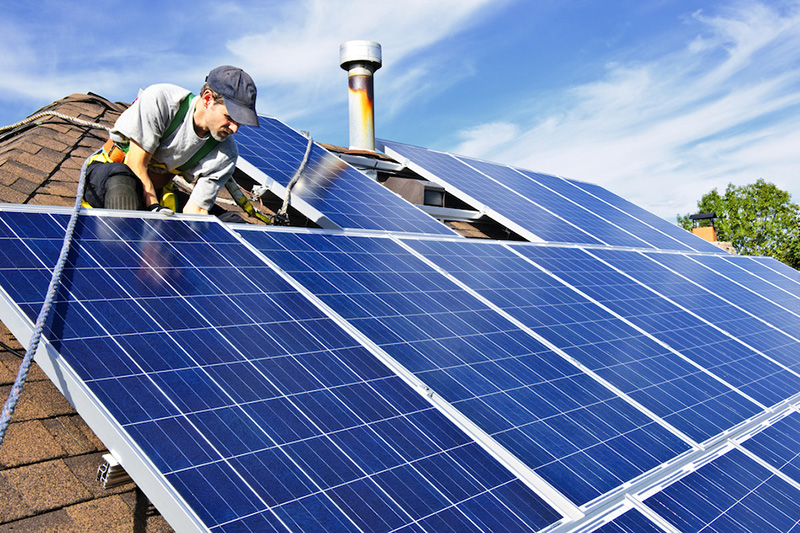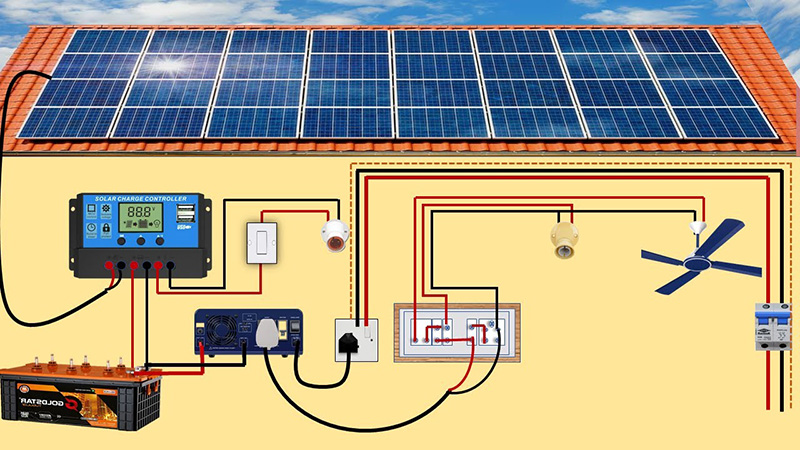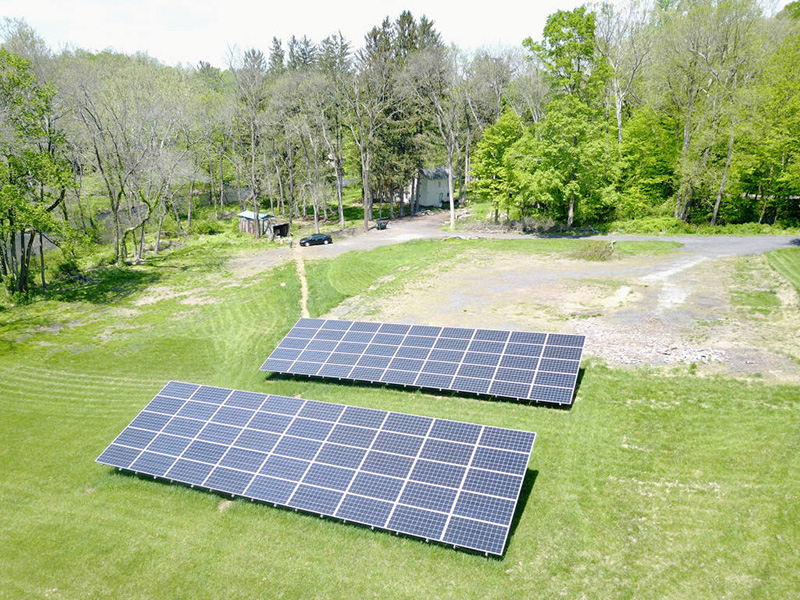Description
Solar panels generate electricity for homes through the photovoltaic effect. When sunlight strikes the solar cells within the panels, it excites electrons. This movement of electrons creates an electric current. This generated current is direct current (DC), which is then converted into alternating current (AC) by inverters, making it suitable for household use.

Understanding Solar Panels
Solar panels, often termed as photovoltaic panels, have gained traction as a leading sustainable energy source. These devices are pivotal in harnessing the sun's energy, transforming it into electricity for a plethora of applications ranging from household consumption to commercial utilization.
What are Solar Panels?
Solar panels are devices adept at capturing sunlight to convert it into usable electricity. Comprising numerous photovoltaic cells, they facilitate the energy conversion process. When sunlight interacts with a solar panel, these cells initiate an electric current, energizing homes, devices, and more. Their prevalence on rooftops, vast solar farms, and even compact portable gadgets underscores their versatility and the burgeoning demand for solar-derived power.
Different Types of Solar Panels
Diverse solar panel variants cater to different needs, each possessing unique advantages and applications:
- Monocrystalline Solar Panels: Originating from a singular crystal structure, these panels take the lead in efficiency rates, attributed to the pristine silicon used in their fabrication. Their uniform dark appearance and rounded perimeters are their distinguishing features.
- Polycrystalline Solar Panels: Crafted from a conglomerate of crystal structures, they exude a distinctive blueish tint. Though their efficiency lags behind their monocrystalline counterparts, they appeal to a more budget-conscious audience.
- Thin-Film Solar Panels: The manufacturing of these involves layering one or multiple photovoltaic materials (examples include silicon, cadmium, or copper) on a foundational substrate. Their efficiency doesn't match up to crystalline-based panels, but they often come with a friendlier price tag.
- Solar Tiles: Redefining the concept of solar panels, solar tiles mimic the appearance of conventional roof tiles. They cater to those eyeing an aesthetically pleasing alternative without the characteristic solar panel look.
Main Components of a Solar Panel
Delving into the anatomy of a solar panel, several components synergistically operate to capture and convert sunlight:
- Photovoltaic Cells: Undoubtedly the linchpin of the solar panel. Embedded with semiconductors, predominantly silicon, they are proficient at sunlight absorption, subsequently producing a direct current (DC).
- Glass Casing: A guardian for the photovoltaic cells, it safeguards them from external adversities. Constructed from resilient, tempered glass, it's engineered for longevity.
- Frame: Aluminum-based, the frame bestows structural support, ensuring the solar panels' durability and resilience against varying climatic conditions.
- Backsheet: Positioned at the rear of the solar panels, it functions as an insulator and stands as a defense against potential electrical hazards.
- Junction Box: An enclosure for the electrical components, it offers shelter from environmental challenges and serves as a nexus for electrical linkages.
In-depth knowledge about the intricacies of solar panels, their myriad types, and integral components empowers individuals to make judicious decisions when pondering over solar energy adoption.

The Science Behind Solar Electricity Generation
Delving deep into the world of solar energy requires an understanding of the science that powers these sustainable devices. Solar panels, though seemingly simple on the surface, rely on complex physical phenomena to generate electricity. The very heart of this process lies in the photovoltaic effect and the operation of photovoltaic cells. Further, the efficiency of these panels remains a critical topic, as it determines the output and potential applications of solar energy in various sectors.
Photovoltaic Effect Explained
The photovoltaic effect is a physical and chemical phenomenon where electric voltage is produced in a material upon exposure to light. It is the foundation of how solar panels function. Essentially, when photons (light particles) hit the surface of a solar panel, they transfer their energy to atoms in the panel. This extra energy nudges electrons loose, and when these free electrons move, an electric current forms.
Materials like silicon are often used in solar panels due to their semiconductor properties. Semiconductors possess a unique energy band structure that facilitates the movement of these electrons and the generation of electricity. For those keen on diving deeper into the intricate details of the photovoltaic effect, the
photovoltaic effect page provides a comprehensive overview.
How Photovoltaic Cells Work
Photovoltaic cells, often simply called solar cells, are the individual units within a solar panel responsible for converting sunlight into electricity. Each cell consists of two layers of semiconductor materials, typically silicon. The top layer is treated to have an excess of electrons, while the bottom layer has a deficit.
When sunlight enters the cell, it energizes the electrons in the top layer. Energized and free, these electrons rush to the bottom layer, creating a flow of electricity in the process. Conductive plates on the sides of the cell collect this electricity, and wires transport it for external use. For a more detailed exploration of the working mechanism of these cells, the
solar cell page is an excellent resource.
Efficiency of Solar Panels
Efficiency in solar panels refers to the proportion of sunlight's energy that a panel can convert into usable electricity. As of recent data, most commercial solar panels boast efficiencies between 15% to 20%. However, the most advanced panels in research environments have surpassed 40%.
Several factors influence a panel's efficiency:
- Material Quality: High-grade silicon or alternative materials typically result in better efficiency.
- Cell Design: Advanced designs can capture more light and convert more of it into electricity.
- Temperature: Solar panels generally prefer cooler conditions. High temperatures can reduce efficiency.
- Angle and Orientation: Panels oriented directly towards the sun and tilted at an optimal angle can capture more sunlight.
It's worth noting that while higher efficiency is generally better, it doesn't always mean it's the most cost-effective option for every application. Consumers often balance efficiency, cost, and space constraints when selecting panels. The topic of solar efficiency is ever-evolving, and those interested can further read about it on the
solar panel efficiency page.
Understanding the science of solar electricity generation is pivotal for both industry professionals and everyday consumers. As research continues and technology evolves, the future holds even more promise for this sustainable energy source.

From Sunlight to Household Electricity
Harnessing the limitless power of the sun and channeling it to power our homes is nothing short of a modern marvel. The journey of photons from the vastness of the cosmos to our electrical sockets involves several critical steps. Each phase, from solar energy collection to its integration into home systems, plays a unique role in ensuring sustainable, reliable energy for households.
Solar Energy Collection
At the heart of solar power generation lies the essential step of capturing the sun's radiant energy. Solar panels, equipped with numerous photovoltaic cells, serve as the primary tools for this process. These cells are specifically designed to absorb sunlight, and their efficiency largely determines the amount of sunlight that can be captured. For instance, while average solar panels convert about 15% to 20% of the sunlight they receive, some high-performance models can achieve conversion rates upward of 40%. One can further explore the science behind
solar energy collection to understand its intricacies.
Conversion of Solar Energy to Direct Current (DC)
Once the sunlight gets absorbed, the real magic begins. Photovoltaic cells in the solar panels facilitate the conversion of this captured sunlight into electricity. When the cells get exposed to sunlight, they become agitated at the atomic level. This agitation causes electrons to move, resulting in the creation of direct current (DC) electricity. Those interested in the technical details can delve deeper into the topic of
photovoltaic cells.
Inverters: Turning DC into Alternating Current (AC)
While the direct current generated by solar panels is a significant achievement, most household appliances run on alternating current (AC). That's where inverters come into play. An inverter is an electrical device that transforms the DC electricity from the solar panels into AC electricity. This conversion ensures that the generated power is compatible with home systems and appliances. Understanding the role and functionality of
inverters can provide greater clarity on their importance in the solar energy process.
Integration with the Home Electrical System
After the conversion to AC, the electricity is almost ready to power a household. This power flows into the home's electrical panel, from where it gets distributed to various appliances and outlets. Any excess electricity that isn't used by the home can often be sent back to the grid, in cases where grid-tied solar systems are installed. Some homes also have battery storage solutions to store surplus energy, ensuring power availability even during nights or cloudy days. The intricacies of
home electrical systems and their integration with solar setups form a topic of extensive study and application.
As solar technology continues to advance, the journey of sunlight to our homes becomes ever more efficient and reliable. The entire process, a blend of physics, engineering, and innovation, stands as a testament to human ingenuity in the quest for sustainable living.

Installation and Positioning for Optimal Performance
Harnessing solar energy for household needs isn't just about having the latest solar panels; it's also about placing and maintaining them effectively. Just like how a plant needs optimal sunlight and care to grow, solar panels require the right positioning and consistent monitoring to yield their best performance. The installation process, from site assessment to regular maintenance, plays a pivotal role in maximizing the efficiency and longevity of solar panels.
Determining the Right Spot for Installation
Selecting an ideal location for solar panel installation is paramount. Factors to consider include:
- Sunlight Exposure: Opt for locations that receive ample sunlight throughout the day. Areas overshadowed by trees, buildings, or other obstructions may not be ideal.
- Roof Condition and Material: The roof's structural integrity should be ensured. It needs to support the panels' weight and handle their installation without damage. Certain roof materials, like slate or cedar tiles, may pose challenges.
- Ground Mounts: For homes where rooftop installation isn't viable, ground-mounted solar systems can be an alternative. These setups require a spacious yard that gets significant sunlight.
- Local Regulations: Some neighborhoods or city regulations might have restrictions or guidelines for solar installations.
For deeper insights into the factors influencing solar panel placement, the topic of
solar panel installation offers extensive details.
The Importance of Solar Panel Angles and Orientation
A solar panel's efficiency is highly influenced by its angle and orientation:
- Angle (Tilt): The tilt should ideally match the latitude of the installation location. For instance, a home situated at a latitude of 40° should ideally have solar panels tilted at 40°.
- Orientation: In the Northern Hemisphere, solar panels should face true south for optimal sunlight exposure, while in the Southern Hemisphere, they should face true north.
- Seasonal Adjustments: Some solar setups allow for periodic angle adjustments to cater to seasonal sun positions.
The science of determining the perfect angle and orientation is rooted in understanding the sun's path. Exploring the concept of
solar azimuth and solar angles can provide clarity on this subject.
Monitoring and Maintenance for Maximum Efficiency
After installation, the journey doesn't end. Regular monitoring and maintenance ensure solar panels operate at peak efficiency:
- Cleaning: Dust, bird droppings, or snow can hinder a panel's ability to capture sunlight. Regular cleaning enhances efficiency.
- System Monitoring: Modern solar systems often come with monitoring software that helps track energy production and identify any anomalies.
- Professional Inspection: Periodic inspections by professionals can catch issues like loose connections, corrosion, or wear and tear.
- Battery Maintenance: If the system includes batteries for energy storage, they too require regular checks to ensure optimal performance.
A deeper dive into the
solar panel maintenance realm can provide a comprehensive view of best practices.
Correct installation and proactive maintenance are as vital as the panels themselves. By optimizing the conditions for solar energy capture and ensuring regular upkeep, homeowners can relish the benefits of solar energy for years to come.
Benefits and Drawbacks of Solar Energy for Homes
The adoption of solar energy in homes has witnessed a significant surge in recent years. This renewable energy source is viewed as a solution to some of the pressing environmental concerns of our times. But like every technology, it brings along its set of advantages and potential limitations. It's essential to weigh these factors before making the switch to solar energy.
Advantages of Solar Power
Solar energy offers a myriad of benefits for homeowners:
- Cost Savings: Over time, solar panels can lead to substantial savings on electricity bills. Depending on the region and local energy prices, homeowners can recoup their installation costs within 5-10 years and then enjoy virtually free electricity.
- Environmental Impact: Solar energy is a clean, green source of power. By going solar, homeowners reduce their carbon footprint, combating the detrimental impacts of fossil fuels.
- Energy Independence: Solar installations can free homeowners from the unpredictability of energy prices and external supply disruptions.
- Home Value Boost: Homes equipped with solar panels often see an increase in value, making it a worthwhile investment.
- Innovative Options: Brands like Tongwei offer cutting-edge solar panels, ensuring homeowners access to efficient and reliable solar technology.
To get a more comprehensive understanding of the advantages, exploring
solar power benefits can be insightful.
Potential Limitations and Concerns
While solar energy presents numerous advantages, there are some aspects to consider:
- Initial Costs: The upfront cost for solar panel installation can be high, although this can be offset by long-term savings and available tax credits or incentives.
- Weather Dependency: Solar energy generation is contingent on sunlight. Regions with prolonged cloudy or rainy days might not reap optimal benefits.
- Space Requirements: Large solar installations require significant space, either on the roof or the ground.
- Maintenance: While generally low-maintenance, solar panels do require occasional cleaning and upkeep to maintain their efficiency.
- Energy Storage: For consistent power during nights or cloudy days, additional investments in energy storage solutions, like batteries, might be necessary.
To get a more rounded perspective on these aspects, one can delve into the topic of
solar energy limitations.
Solar energy, with its array of advantages and certain limitations, remains a formidable player in the realm of sustainable living. By choosing brands like Tongwei and understanding the broader picture, homeowners can make informed decisions on harnessing this potent energy source.







